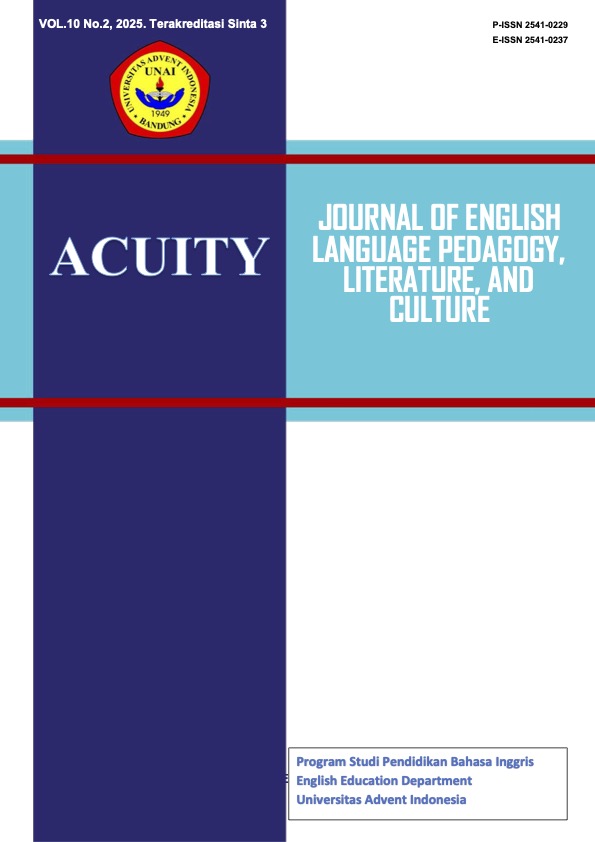Exploring Inflectional Morphemes in Sentences Written by EFL Students
Keywords:
Morphology, Inflection Forms, Regular form, Irregular formAbstract
The objective of this research was to find out the types of inflectional morphemes that the students frequently misused and to find out the difficulty factors faced by students in using the type of inflectional morphemes. The population of this research consisted of 5th-semester students from the English Education Study Program at Tadulako University. The sample was selected using a simple random sampling technique, and there were 136 students in the 5th-semester class. The method of this research depends on the quantitative descriptive data using statistical analysis. Tests and questionnaires were used to collect the data. The researchers found that the ablaut adjective as an irregular form is the type of inflectional morphemes frequently misused by the students; the frequency of many incorrect forms is 160, and the difficulty factors that are affecting the students' use of inflectional morphemes are psychological as internal factors and peer and advisor support as the external factors.
Downloads
References
Febriani, T. N. (2022). “Writing is challenging”: factors contributing to undergraduate students’ difficulties in writing English essays. Erudita: Journal of English Language Teaching, 2(1), 83–93. https://doi.org/10.28918/erudita.v2i1.5441
Fitria, T. N. (2020). An Analysis of Derivational and Inflectional Morpheme in Selected News From Tempo.Co. Rainbow: Journal of Literature, Linguistics and Cultural Studies, 9(2), 146–155. https://doi.org/10.15294/rainbow.v9i2.40348
Gatot, H., Anwar, A., & Setyowati, E. (2001). Exploring the Descriptive Research Methodology. Journal of Educational Research and Practice, 12(4), 235–247.
Hyland, F. (2000). ESL Writers and Feedback: Giving More Autonomy to Students. Language Teaching Research. Open Journal of Social Sciences, 4(1), 33–54. http://dx.doi.org/10.1177/136216880000400103
Ifadloh, N., Najerin, M. R., Nufus, Z., & Ulum, M. (2022). An Analysis of Inflectional Morphemes in a Short Story “The Child’s Story” by Charles Dickens. SALEE: Study of Applied Linguistics and English Education, 3(2), 110–123. https://doi.org/10.35961/salee.v3i2.330
Manihuruk, L. M. E. (2022). Error Analysis in Using Inflectional Morphemes Students’ Recount Text of English Students. IJECA (International Journal of Education and Curriculum Application), 5(1), 53. https://doi.org/10.31764/ijeca.v5i1.7783
Nattinger, J. (2014). Some current trends in vocabulary teaching. In Vocabulary and Language Teaching.
Nurhayati, N. (2019). Ablaut and Vowel Gradation: The Effect of Stress Shifts on Vowel Changes. Journal of Linguistics and Language Teaching, 15(2), 87–101.
Qasem, H., Asaad, M., & Shabdin, A. A. (2019). Importance of Morphological Awareness to Academic Writing Among Second Language Postgraduate Students. Juornal English, 4(3), 156–167. https://doi.org/10.5281/zenodo.1307432
Rimikis, Nephawe, F. T., & Lambani, M. N. (2023). Exploring perspectives on the approach for teaching ablaut principles to English L2 learners: a case study in South African secondary schools. Journal on English as a Foreign Language, 13(2), 657–680. https://doi.org/10.23971/jefl.v13i2.6623
Santiwi, W., Simanjuntak, B., Nasution, Y., & Muslim. (2023). Error Analysis Students’ Ability in Using Regular and Irregular Verb at the Second Grade of SMP Satria Dharma Perbaungan. Journal Continuous Education, 4(1), 40–49.
Seprudin. (2022). An Analysis of Inflectional Affixes in the Discourse on the Method Text By Rene Descartes. Jurnal Ilmu Pendidikan Dan Humaniora, 8(1), 55–64.
Smith, R., Lehman, C. S. (2003). Comparative Definitions of Morphology. Journal of Linguistic Theory, 8(3), 123–139.
Sukmawati, Salmia, S. (2023). Population, Sample (Quantitative), and Selection of Participants/Key Informants (Qualitative). Jurnal Pendidikan, 7(1), 131–140.

















